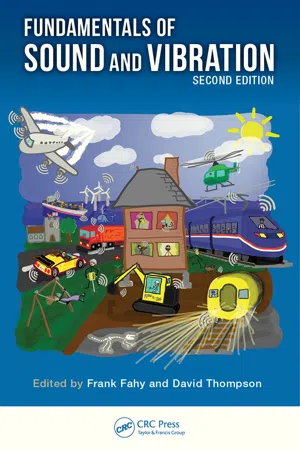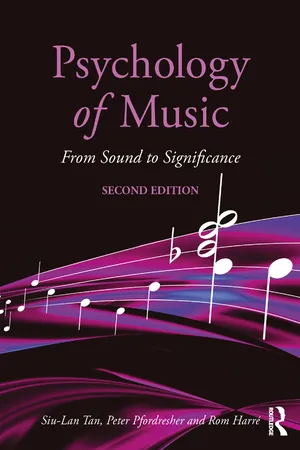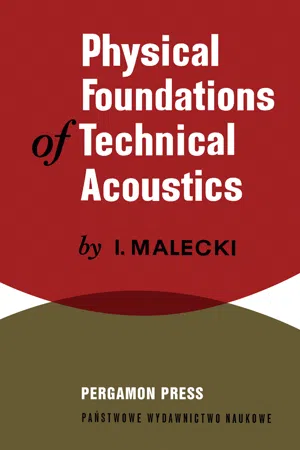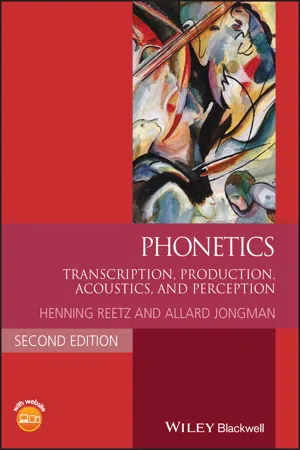Physics
Acoustics
Acoustics is the branch of physics that deals with the study of sound, its production, transmission, and effects. It encompasses the behavior of sound waves in various media, such as air, water, and solids, and explores topics like sound absorption, reflection, and diffraction. Acoustics also investigates the perception and psychological effects of sound on humans and animals.
Written by Perlego with AI-assistance
Related key terms
1 of 5
10 Key excerpts on "Acoustics"
- eBook - PDF
- Marc Asselineau(Author)
- 2015(Publication Date)
- CRC Press(Publisher)
3 Chapter 2 Acoustics 2.1 DEFINITION OF Acoustics Acoustics is defined as the science of sound. The word comes from the Greek acoustikos , meaning “for hearing.” Hearing is not limited to the human species. It is crucial in the animal world, as it enables them to detect an incoming danger or help pinpoint prey. More to the point, speech is used by many species, especially humans, for communication. In the antique world Acoustics was sometimes considered the science of sciences. Nowadays, it features numerous widely branches ranging, for example, physical Acoustics, building acous-tics, underwater Acoustics, etc. A quite comprehensive list can be found in [1, 2]. Basically, when dealing with Acoustics, three entities are involved: a source, a propagation medium, and a receiver. The source converts energy into vibrations of the propagation medium; it can be, for example, a vibrating rod or a surface. The propagation medium can be solid (e.g., metal, wood), liquid (e.g., water), or gas (e.g., air). 2.2 BRIEF HISTORY The reader interested in the history of Acoustics can find more developed information in references [3–6]. Here is only a brief reminder of a few points of interest. In the antique world Acoustics was sometimes considered the science of sciences. Musical Acoustics were studied by scientists and philosophers who dreamed to discover the secrets of world order. During his investigations of musical intervals, Pythagoras (6th century BC) discovered harmonics. Vitruvius wrote a treatise featuring considerations on theatres, including echoes and reverberation (20 BC); he also compared sound propagation to the circles in water. Aristotle explained wave motion as contractions and expansions of air bumping into the one next to it. The knowledge of the Greeks was passed on to the Romans and the Arabs, with the latter developing during the Middle Ages. Later the Renaissance saw the development of architec-tural Acoustics and musical Acoustics again. - eBook - PDF
- Frank Fahy, David Thompson, Frank Fahy, David Thompson(Authors)
- 2015(Publication Date)
- CRC Press(Publisher)
9 Chapter 2 Fundamentals of Acoustics* David Thompson and Philip Nelson 2.1 INTRODUCTION TO SOUND Acoustics is the science and study of sound. In this book, we concentrate on sound in air at audible frequencies. The field of Acoustics extends to include many related topics such as environmental Acoustics, musical Acoustics, architectural Acoustics, electro-Acoustics, underwater Acoustics and ultra-sonics. This chapter introduces the physical processes involved in sound generation and propagation which form the basis for many of these related fields. Sound is a wave phenomenon by which energy is transmitted through a medium via vibration of the medium and pressure (or stress) fluctuations within it. Before turning to the study of wave phenomena, however, it is helpful to consider the nature of sound signals arriving at a listener loca-tion, irrespective of the source of that sound. The acoustic quantity which is sensed by the human auditory system is the variation in air pressure, so we will concentrate on this quantity here. A sound signal can be described in terms of its frequency components and associated amplitudes, as will be explained further in the following sections. We are familiar with the concepts from music, where the ‘loud-ness’ corresponds to the amplitude of the sound and the ‘pitch’ of a note cor-responds to its frequency: at ‘concert pitch’, an A (the one above middle C) is tuned to a frequency of 440 Hz (cycles per second). Thus a piano string, for example, producing such a note will oscillate 440 times per second, although not necessarily with a sinusoidal motion. For audible sound in air, the range of frequencies and amplitudes that should be considered is defined to a large extent by the range of human hearing (see also Chapter 6). Thus the frequency range of the auditory system extends approximately from 20 to 20,000 Hz. * Large parts of this chapter are based on material first published in Nelson, P.A. - eBook - PDF
Psychology of Music
From Sound to Significance
- Siu-Lan Tan, Peter Pfordresher, Rom Harré(Authors)
- 2017(Publication Date)
- Routledge(Publisher)
Part I Foundations 2 The Acoustics of music Brittle twigs and dry leaves crunching underfoot, rain pellets hammering down on a tin roof, the roar of a crowd at a football game. Each of these sounds has its characteristic acous- tic features and patterns that make it distinct from others. A distant flute on a hillside, the shimmering tones of a gamelan ensemble in a garden courtyard, the thunderous fortissimo chord of a full symphonic orchestra in a grand concert hall. Each of these musical sounds, too, has a distinct acoustic signature. All these auditory events – musical and nonmusical – are dispersed into various sound environments: open air, outdoor arenas, and crowded concert halls. The sound waves often travel a great distance to our ears, and the physical patterns must be transformed into neural signals in the ear and brain. It sounds like a complex process. Yet most of us quite effortlessly recognize the sounds and their sources, defining some as ‘noise’ and some as ‘music,’ and describing them as ‘sweet’ or ‘rough,’ ‘mellow’ or ‘shrill.’ Most of this book focuses on the subjective experience of music as a result of neural, cognitive, developmental, and social variables. However, the raw material that makes up music is the physical stimulus we call sound. Note that this stimulus is something distinct from either the object making the sound (e.g., a guitar), or our ear’s response to the sound. Acoustics is the science of sound, referring specifically to its production, transmission, and reception (American Heritage Dictionary of the English Language, 2016). The particular domain of musical Acoustics focuses on the ‘mechanisms of sound production by musical instruments, effects of reproduction processes or room design on musical sounds, [and] human perception of sound as music’ (Hall, 2001, p. 2). The present discussion begins with a brief description of the physical characteristics of sound waves ( frequency, amplitude, power spectrum). - eBook - PDF
- I. Malecki(Author)
- 2013(Publication Date)
- Pergamon(Publisher)
In this book we shall confine ourselves to presenting general principles of this new branch of Acoustics in Chapter 14. 6 PHYSICAL FOUNDATIONS OF TECHNICAL Acoustics In the development of a science, it is often hazardous to make predictions; however, many facts indicate that the development of Acoustics as a scientific discipline is still far from complete. This science is faced with new problems unsolved as yet, which are concerned with waves of very high frequencies, perception of transients, the influence of the microstructiire of materials on wave propagation, etc. In accordance with the assumed criteria of division, the whole of modern Acoustics may be divided into several somewhat indistinct branches, since research on one problem may be conducted simultaneously in many fields. At present we are not concerned, however, with a bibliographical classification of the type such as e.g. is used in the Journal of the Acoustical Society of America, but with a systematic study of the whole scientific material available. Such a systematic study can be carried out on the basis of practical applications of Acoustics, or on typical research methods. The former cri-terion of division is usually adopted in textbooks on acoustical engineer-ing. Typical areas of the applications of Acoustics and electro-Acoustics may be set down in the following manner: (a) construction of musical instruments (b) design of halls with predetermined acoustical properties (c) noise control (d) design and manner of using electro-acoustic sound transducers together with equipments for amplification, transmission and recording of signals (e) passive and active application of ultrasonics (f) hydrolocation (g) hearing and speech aids. - eBook - PDF
Phonetics
Transcription, Production, Acoustics, and Perception
- Henning Reetz, Allard Jongman(Authors)
- 2020(Publication Date)
- Wiley-Blackwell(Publisher)
Phonetics: Transcription, Production, Acoustics, and Perception , Second Edition. Henning Reetz and Allard Jongman. © 2020 John Wiley & Sons, Inc. Published 2020 by John Wiley & Sons, Inc. Companion website: www.wiley.com/go/reetz/phonetics We have described speech sounds in terms of the way they are produced and how they can be transcribed by phonetic symbols on paper, and we have described in detail the organs and mechanisms by which they are produced. Eventually, all these activities lead to the production of speech sounds . The science to describe sound is known as Acoustics. This chapter describes the basic concepts of acous-tics, focusing on sound waves. It introduces the concepts of frequency , amplitude , and phase , and ways of measuring and representing them. Basic Acoustics in a nutshell Sounds are actually tiny and fast air pressure changes . Although they are very small, these air pressure changes can move a small and light membrane in a microphone, which converts these movements into electric changes, which in turn are converted by a computer or digital recorder into a sound file (see Chapter 8 for details). This sound file can then be made visible on a computer screen as a waveform or oscillogram (see Figure 1.2), which reflects the air pressure in relation to the average air pressure around you (which you might see in a weather forecast as “High”s and “Low”s). Feeding this information back through an amplifier and into a loudspeaker will move the membrane in the speaker back and forth in the same way that the membrane was once moved in the microphone; hence, this leads to air pressure variations which you will hear as sound again. When we speak (or play an instrument or make any other audible noise) sound waves travel through the air from their source to wherever they can go to (i.e. radially away from their source). Physically speaking, sound waves Basic Acoustics 7 114 Basic Acoustics transport energy through space and time. - Adem Ozcelik, Ryan Becker, Tony Jun Huang(Authors)
- 2023(Publication Date)
- Wiley-VCH(Publisher)
37 2 Basic Theories and Physics of Acoustic Technologies Khemraj G. Kshetri and Nitesh Nama University of Nebraska-Lincoln, Department of Mechanical and Materials Engineering, 1400 R St, Lincoln, NE 68588, USA 2.1 Introduction Acoustic waves refer to mechanical waves that propagate energy through an elastic media via pressure fluctuations. Acoustics is a classical field of physics and has attracted scientific interest from researchers dating as far back as the eighteenth century [1–5]. Specifically, the propagation of acoustic waves in fluid-solid media as well as their interaction with immersed particles (e.g. solid objects, liquid droplets, or gas bubbles) has been the subject of extensive experimental and theoretical research from prominent scientists including Chladni [1], Faraday [2], König [3], Kundt [4], and Rayleigh [5]. Since then, acoustic technologies have been employed for a broad and diverse range of scientific endeavors, with applications, including architectural and musical Acoustics [6–8], underwater Acoustics [9, 10], physical Acoustics [11, 12], acoustic imaging and sensing [13–16], and medical Acoustics [14, 17]. Recently, acoustic technologies have attracted renewed interest in the life sciences due to their suitability and potential for biomedical applications [18–21].- eBook - PDF
Structural Acoustics
Deterministic and Random Phenomena
- Joshua E. Greenspon(Author)
- 2016(Publication Date)
- CRC Press(Publisher)
9 © 2011 by Taylor and Francis Group, LLC 2 Fundamentals of Acoustics and Structural Acoustics* 2.1 Introduction A unified treatment of the principles of linear Acoustics must begin with the well-known phenomenon of single-frequency Acoustics. A second essential topic is random linear Acoustics, a relatively new field, which is given a tuto-rial treatment later in this book. The objective is to present the elementary principles of linear Acoustics and then to use straightforward mathematical development to describe some advanced concepts. Section 2.2 gives a physical description of phenomena in Acoustics. Section 2.3 starts with the difference between linear and nonlinear Acoustics and leads to the derivation of the basic wave equation of linear Acoustics. Section 2.4 addresses the intensity and energy of the one-dimensional harmonic wave. Section 2.5 discusses the fundamentals of normal-mode and ray acous-tics, which is used extensively in studies of underwater sound propagation. In Section 2.6, details are given on sound propagation as it is affected by bar-riers and obstacles. Sections 2.7 and 2.8 deal with waves in confined spaces; sound radiation, with methods of solution to determine the sound radiated by structures; and the coupling of sound with its surroundings. All of these areas are discussed in references 1–12. 2.2 Physical Phenomena in Linear Acoustics 2.2.1 Sound Propagation in Air, Water, and Solids Many practical problems are associated with the propagation of sound waves in air or water. Sound does not propagate in free space. It must have a dense * This chapter was published in Encyclopedia of Physical Science and Technology , vol. 1, Greenspon, J. E., 114–152. Copyright Elsevier (1992). 10 Structural Acoustics: Deterministic and Random Phenomena © 2011 by Taylor and Francis Group, LLC medium in which to propagate. - eBook - PDF
- T Leighton(Author)
- 2012(Publication Date)
- Academic Press(Publisher)
1 The Sound Field 1.1 The Acoustic Wave Introduction: Acoustic Regimes Whether it be the bang of an explosion or the steady sine-wave tone of a whistle, an underwater sonar pulse or the output of a clinical foetal scanner, * sound' is a waveform consisting of density variations in an elastic medium, propagating away from a source. Perhaps the most immediate property of sound is its frequency, or pitch, which is usually measured in cycles per second, or hertz (Hz). Not only is our perception acutely sensitive to differences in pitch, but we tend also to categorise sound into various regimes depending on the frequency. The restriction of a particular type of sound to a particular frequency regime arises through the limitations of the devices we use to generate and detect sound. To generate sound one must do mechanical work on the medium (in speaking, for example, by setting the air into motion through vibration of the vocal cords). Similarly in the detection of sound, the wave does mechanical work on the detector (in hearing through acoustic pressure signals causing the eardrum to vibrate). Devices such as the vocal cord and the eardrum, which convert energy from one form to another, are called transducers. Thus sound represents the transmission of mechanical energy and relies on both the elastic and inertial properties of the medium through which it travels. Since it is a relatively low-energy phenomenon, 1 detection of sound relies very often on utilising a mechani-cal resonance. Therefore, like any such resonator, a sound transducer will be limited in the range of frequencies to which it has a good response. 2 Figure 1.1 is a logarithmic representation of the sensitive frequency regimes of some transducer systems, spanning nine decades in frequency. Human hearing is said to operate in the range 20-20 000 Hz (20 kHz), though we lose sensitivity to the higher frequencies as we age. From this range, the terms sonic, ultrasonic and infrasonic are defined. - No longer available |Learn more
- Robert Thayer Sataloff, Joseph Sataloff, Robert Thayer Sataloff, Joseph Sataloff(Authors)
- 2006(Publication Date)
- CRC Press(Publisher)
2 The Physics of Sound Robert T. Sataloff Drexel University College of Medicine, American Institute for Voice and Ear Research, and Graduate Hospital, Philadelphia, Pennsylvania, USA Joseph Sataloff Thomas Jefferson University, Philadelphia, Pennsylvania, USA 1. Sound 3 2. Sound Waves 4 2.1. Characteristics of Sound Waves 4 2.1.1. Components of Sound 5 3. Measuring Sound 9 3.1. Intensity 11 3.2. Decibel 11 3.2.1. A Unit of Comparison 11 3.2.2. Two Reference Levels 11 3.2.3. Formula for the Decibel 12 3.2.4. Important Points 13 4. dBA Measurement 15 References 17 Fortunately, one need not be a physicist in order to function well in professions involved with hearing and sound. However, a fundamental understanding of the nature of sound and terms used to describe it is essential to comprehend the language of otologists, audio-logists, and engineers. Moreover, studying basic physics of sound helps one recognize complexities and potential pitfalls in measuring and describing sound and helps clarify the special difficulties encountered in trying to modify sources of noise. 1. SOUND Sound is a form of motion. Consequently, the laws of physics that govern actions of all moving bodies apply to sound. Because sound and all acoustic conditions behave consist-ently as described by the laws of physics, we are able to predict and analyze the nature of a 3 sound and its interactions. Sound measurement is not particularly simple. The study of physics helps us to understand many practical aspects of our daily encounters with sound. For example, why does an audiologist or otologist use a different baseline for decibels in his office from that used by an engineer or industrial physician who measures noise in a factory? Why is it that when hearing at high frequencies is tested, a patient may hear nothing and then suddenly hear a loud tone? Yet, all the examiner did was move the earphone a fraction of an inch. - Talbot Hamlin(Author)
- 2019(Publication Date)
- Columbia University Press(Publisher)
8 Acoustics By VESPER A. SCHLENKER T H E K N O W L E D G E of architectural Acoustics has gradually pro-gressed from the non-predictable and capricious status it held at the beginning of the century to the level of an exact science and a branch of engineering. The architect and the builder may now design and erect structures with assurance that their Acoustics will be satisfactory. But in every case acoustical performance will necessarily be successful only in pro-portion to the correct incorporation of known requirements for controlling speech and music and for masking the undesirable noises which may originate inside and outside the building. The requirements for sound control have slowly emerged out of the mass of quantitative measurements made possible by the amazing developments in electronics and electro-acoustical instruments during recent decades. The consensus of opinion in the leading schools of architecture is that architectural Acoustics is a true branch of engineering and that the advice of a competent consultant should be available to the architect from the very in-ception of his design. It is imperative, however, that the architect should understand acoustic principles and that the architectural student should re-ceive at least one semester in the fundamentals and application of Acoustics so that he will recognize possible acoustical difficulties in his designs and know when to seek competent assistance. Within the space allotted here it will not be possible to cover architectural Acoustics from the engineering point of view. Rather, the intention is to point out the results of the impingement of modern Acoustics upon twentieth-century architecture. It should be recognized that bad Acoustics can now be prevented by proper design and construction rather than cured by alterations after the building has been completed. In this way the cost incidental to acoustical design and construction becomes a legitimate capital charge rather
Index pages curate the most relevant extracts from our library of academic textbooks. They’ve been created using an in-house natural language model (NLM), each adding context and meaning to key research topics.









